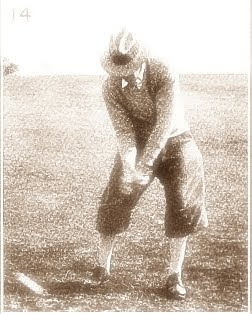The truth is that ball lies on the ground in front of us. It requires hitting not only out but also down at the ball with a clubhead positioned up and inside at the backswing end. If we assume that the best biokinetically sound downswing plane is low (elbow plane) and that golfers achieve this plane as early as possible (EEP) there is no possibility of not having an OTT element in the motion. Swings of best players and ballstrikers starting from Bobby Jones through Ben Hogan, Jimmy Demaret and Sam Snead to George Knudson and Moe Norman had it for sure. Their downswing planes were above their backswing planes, however, their shafts, clubheads and sweetspots shallowed forming a great elbow plane downswing. Hands were OTT while sweetspots were approaching still from inside ensuring both power as well as great path-clubface angle relationship.
Of course, such a scenario is possible only if the downswing plane is low enough (elbow plane). That is one of a few reasons why the EP is biokinetically soundest plane when talking about repeatability and accuracy - much better than the shoulder plane (TSP) which requires rather reverting natural OTT tendency and shallowing hands plane through the downswing, therefore, just bringing a whole bunch of timing issues into the motion as well as not feeding our subconscious minds with essence of using maximum power.
We cannot underestimate the power element. Not coincidentally, when trying to hit hard an object lying on the ground we use OTT move. Our subconscious minds know very well that cooperating with gravity is an important piece of puzzle - hence so many beginners are over-the-toppers. Unfortunately, OTT can be a deadly thing when not adapted correctly into the motion since it may lead to an outside-to-in cut across the ball. Thus, it is crucial to take necessary measures, best of course at setup, that ensure hitting the ball with a powerful OTT move while still being able to deliver the sweetspot from the inside.
That is why the role of such elements as diagonal stance, biokinetical grip or sequentiality of the motion from the ground up cannot be overestimated. They mechanically promote shallowing the shaft despite the hands downswing plane goes over their backswing plane and, therefore, help to create proper conditions. Golfers should never be prescribed endless repetitions and drills that are against their subconscious minds but, instead, informed how to adapt correctly these elements. It is really hard to believe that golf instruction has not found this way so far and often offers advices that completely neglect elements that are somehow naturally imposed by subconscious minds of golfers.
It is worth mentioning here that over the top move is not the only one "subconscious-mind-friendly" natural move improperly cursed by today's golf instruction. Another big example is the slap-hinge release type that probably have even worse connotation today. Today's golf instruction curses everything that equals to losing the rear wrist angles before the follow through phase calling it erroneously as flip. The truth is that flipping is an error which makes a golfer release his angles completely too soon before contact while the slap-hinge release delivers the angles to the impact zone and lets the wrists release naturally after contact.
Too bad that we very seldom remember such great players as Wild Bill Mehlhorn (whom the very Ben Hogan called as the best he ever saw from tee to green - see above & below) or such great golf swing theorists (and, simultaneously, superb players) as Sir Henry Cotton, who differentiated the three release types having the slap-hinge release as one of the three. Many could learn a lot from them today, believe me.
Nota bene what Hogan developed after 'the secret' is a release that is somehow between the push and the slap-hinge one, i.e. merging stability of the push release until impact and subconscious-friendly release of wrist angles after impact. It allowed Hogan to leave fears of handle dragging what accompanied him before 'the secret' and could be easily observed as well as not returning to dreaded crossover release that plagued him in his early stage of his carreer.















